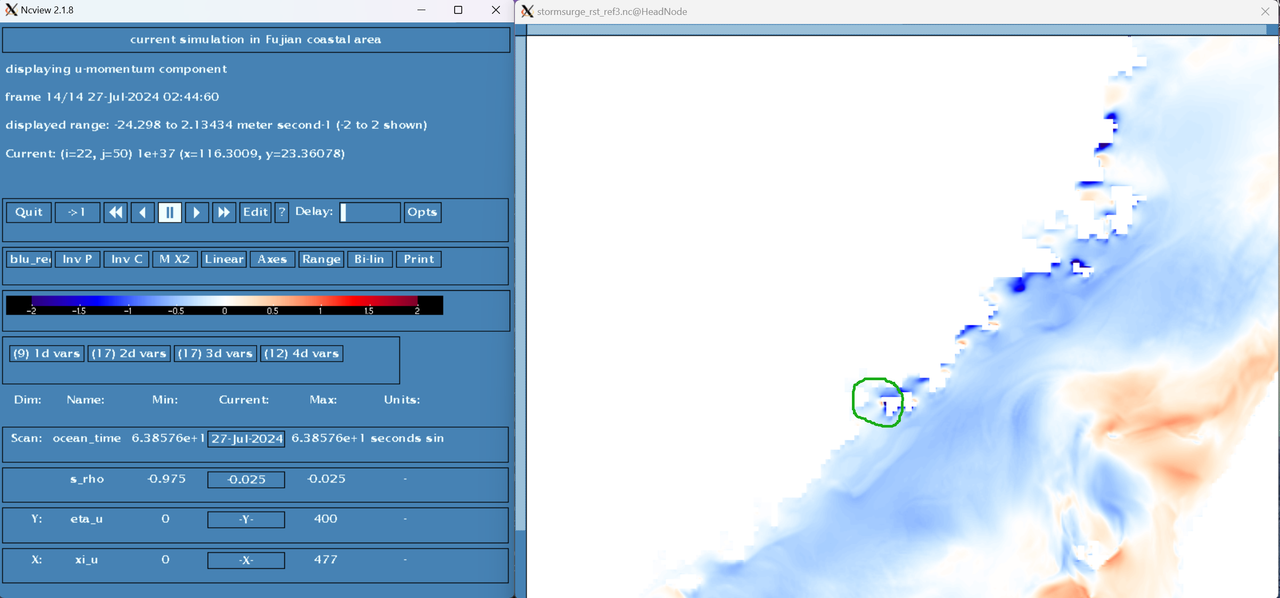I am currently utilizing ROMS to simulate changes in water levels during the passage of a typhoon. In this simulation, I am using wave variable inputs as a forcing file rather than coupled with SWAN. My main purpose is to investigate the impact of wave-enhanced bottom stress on storm surge. Initially, I had planned to perform a nested simulation to obtain high-resolution results; however, the model frequently encountered instability during the initial step. Consequently, I have opted to begin with a simpler approach by simulating a single grid.
My CPP options are configured as follows:
However, after running the model for 16 hours, it experienced a blow-up. I have several questions:#define ROMS_MODEL
#undef NESTING
#define UV_ADV
#define CURVGRID
#define UV_COR
#undef UV_LOGDRAG
#define LIMIT_BSTRESS
#define UV_VIS2
#define TS_U3HADVECTION
#define TS_C4VADVECTION
#define SALINITY
#define TS_DIF2
#define NONLIN_EOS
#define BULK_FLUXES
#define EMINUSP
#define ATM_PRESS
#define SOLAR_SOURCE
#define AVERAGES
#define DIAGNOSTICS_TS
#define DIAGNOSTICS_UV
#define SOLVE3D
#define SPLINES_VVISC
#define SPLINES_VDIFF
#define MASKING
#define SPHERICAL
#define DEBUGGING
#define MIX_GEO_UV
#define MIX_GEO_TS
#define LMD_MIXING
#define LMD_SKPP
#define LMD_BKPP
#define LMD_NONLOCAL
#define LMD_SHAPIRO
#define RI_SPLINES
#define WEC_VF
#define WET_DRY
#ifdef WEC_VF
# define WDISS_THORGUZA
# define WEC_BREAKING
# define ROLLER_RENIERS
# define WEC_ROLLER
# undef WEC_WCAP
#endif
#undef STREAMING
# ifdef STREAMING
# define SURFACE_STREAMING
# define BOTTOM_STREAMING
# define BOTTOM_STREAMING_YU
#endif
#define SSW_BBL
#ifdef SSW_BBL
# define SSW_CALC_ZNOT
# define SSW_CALC_UB
# undef ANA_SEDIMENT
# undef SSW_LOGINT
# undef SSW_ZORIP
#endif
#undef SSH_TIDES
#ifdef SSH_TIDES
# define UV_TIDES
# define ADD_FSOBC
# define ADD_M2OBC
#endif
#define HDF5
1. I have checked my initial and boundary files, and they appear to be normal. Since I am particularly concerned about flooding during storm surges, I enabled the wet_dry option and conducted a separate test without activating any other wave options, which ran without issues. Therefore, is the problem indeed related to the settings of ssw_bbl? I have defined #define SSW_CALC_UB because I am not coupling with the SWAN model and cannot provide bottom orbital velocity to ROMS. Additionally, SSW_BBL requires the user to specify the bottom wave period, and I have approximated this using the peak surface wave period. Could this be a potential issue?
2. Regarding the setting of the WEC_ALPHA parameter, I referred to the Sandy case study and set it to 0. Does this mean that it is unnecessary to define ROLLER_RENIERS and WEC_ROLLER? Could this be the cause of the blow-up?
3. I reviewed the run log and noticed something concerning: the side boundary condition for ubar_stokes appears as a string of garbled text. As I am not very familiar with Fortran, I find it difficult to understand the reason for this issue, even though I set the boundary condition for ubar_stokes to Gradient in the input file. I am worried that COAWST may not be correctly reading this boundary condition.
Any suggestions would be greatly appreciated. Thank you for your assistance.
